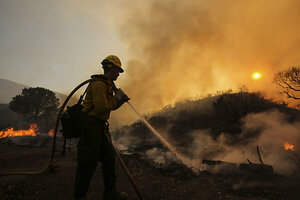California wildfires: How firefighters are coping with wild weekend
More than 5,000 firefighters continued to battle a blaze on the Central Coast this weekend, while another fire broke out in the Central Valley region.

A firefighter battles a wildfire near Placerita Canyon Road in Santa Clarita, Calif., July 24, 2016. Thousands of homes remained evacuated Sunday as two massive wildfires raged in tinder-dry California hills and canyons.
Ringo H.W. Chiu/AP
A 10-day-old wildfire continued to spread across California's Central Coast this weekend, as another blaze broke out Saturday in the Central Valley region.
More than 5,000 firefighters are now battling the fire north of Big Sur, which officials say has grown to 62.5 square miles, or about the size of San Francisco. So far, the blaze has destroyed 57 homes and 11 outbuildings, forcing hundreds of evacuations and taking the life of a bulldozer operator.
Now, winds have begun to push the fire away from residential areas and into the Los Padres National Forest.
"It's good in a way, but it means there will be more acreage burning," said Maria Lara, spokesperson for Cal Fire, to the Los Angeles Times. "It's also more steep terrain to put our crews in, and sometimes we don't have access to those areas."
As of Sunday morning, the blaze was 18 percent contained. Officials said firefighters would likely continue to battle the fire for another month.
Meanwhile, in Central California, the blaze that broke out Saturday afternoon had grown to nearly three square miles, thanks to temperatures over 100 degrees, low humidity, and an abundance of dead trees.
"We watched it explode, coming across Old Millerton Road, and it just keeps getting bigger and bigger," Dana Bays, one of many residents who were forced to evacuate the area, told local television station KFSN-TV.
California has faced a number of wildfires this year, as the state suffers through its fifth year of drought conditions. As of Sunday, a 65-square-mile fire that broke out in Santa Clarita, a northern suburb of Los Angeles, had been 93 percent contained by fire crews after claiming one life and 18 homes.
Some 1,038 firefighting personnel were working to mop up, put out hot spots and shore up and extend containment lines, according to the USFS, the Los Angeles Daily News reports.
That blaze and others like it have been able to spread more quickly than usual for this time of year due to plants drying out earlier from the high temperatures and low humidity, Max Moritz, a fire ecology and management expert at the University of California, Berkeley, told The Christian Science Monitor's Christina Beck last month. Typically, he said, fires are worse in the fall, when the winds are stronger.
“We're going to have a critically dry and flammable situation late in the season this year," Professor Moritz said. "This is not even close to the peak of the season."
This report contains material from the Associated Press.

